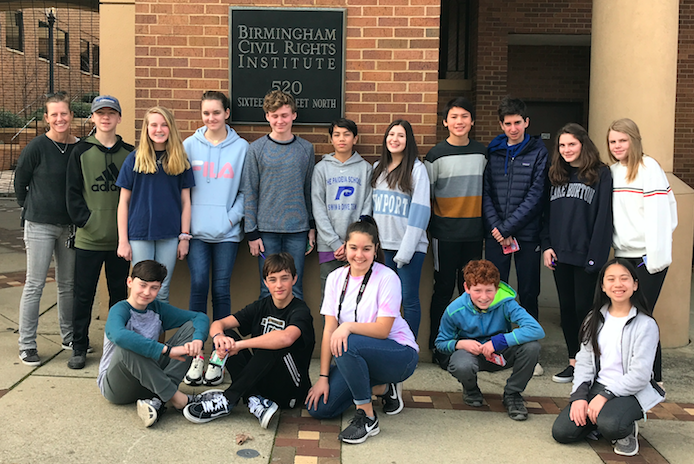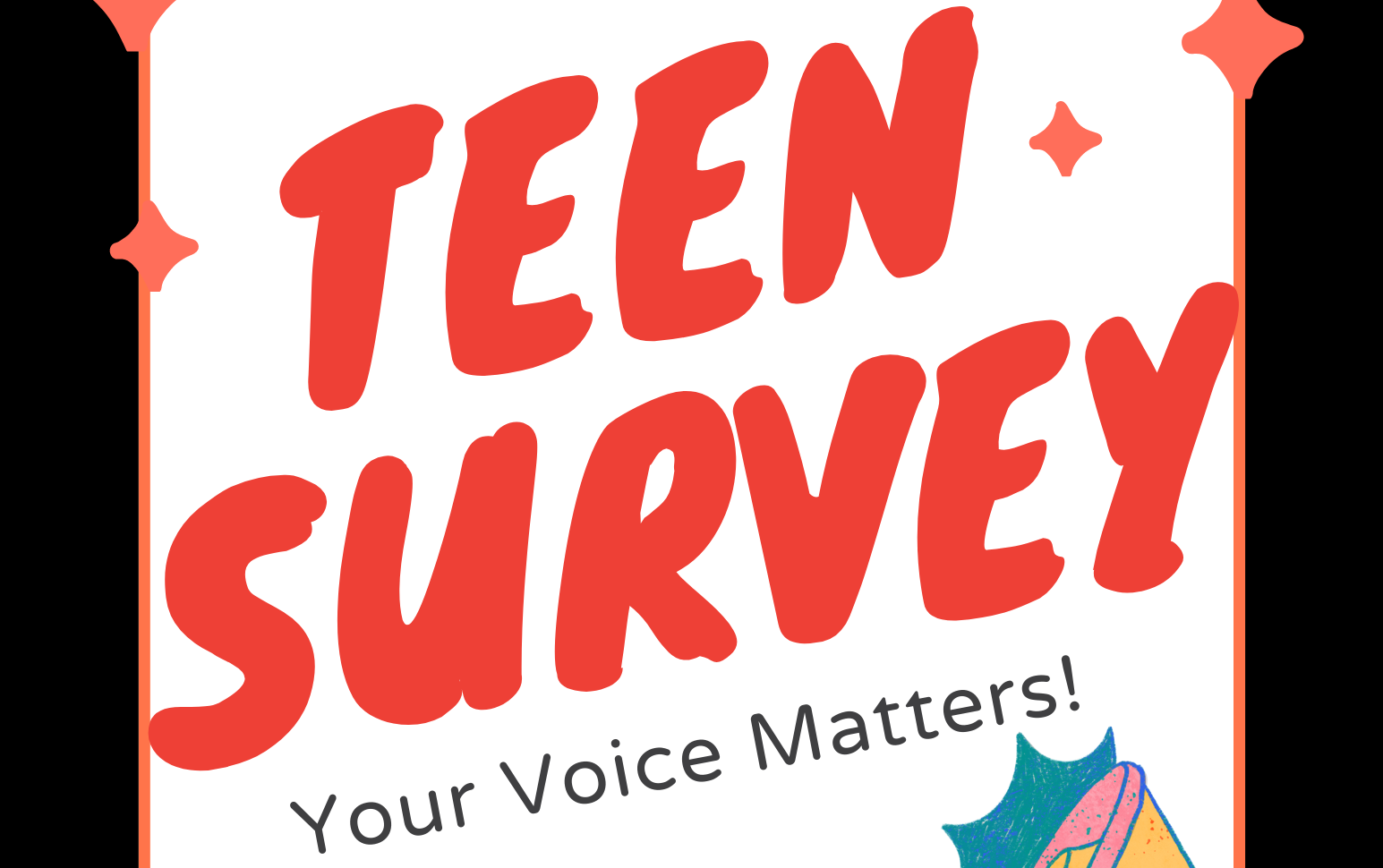Our eighth-grade class takes a course focusing on race, class, and gender as a part of our social studies class. We went to Montgomery and Birmingham, Alabama, in order to learn about what it was like to live in the times of slavery and segregation, and how our law system today impacts people of color. We visited Equal Justice Initiative, The Legacy Museum, The National Memorial for Peace and Justice, The Birmingham Civil Rights Institute, and The 16th Street Baptist Church. We came away with a hurtful, but better, understanding of how unfair our country is.
– Arden Lunsford
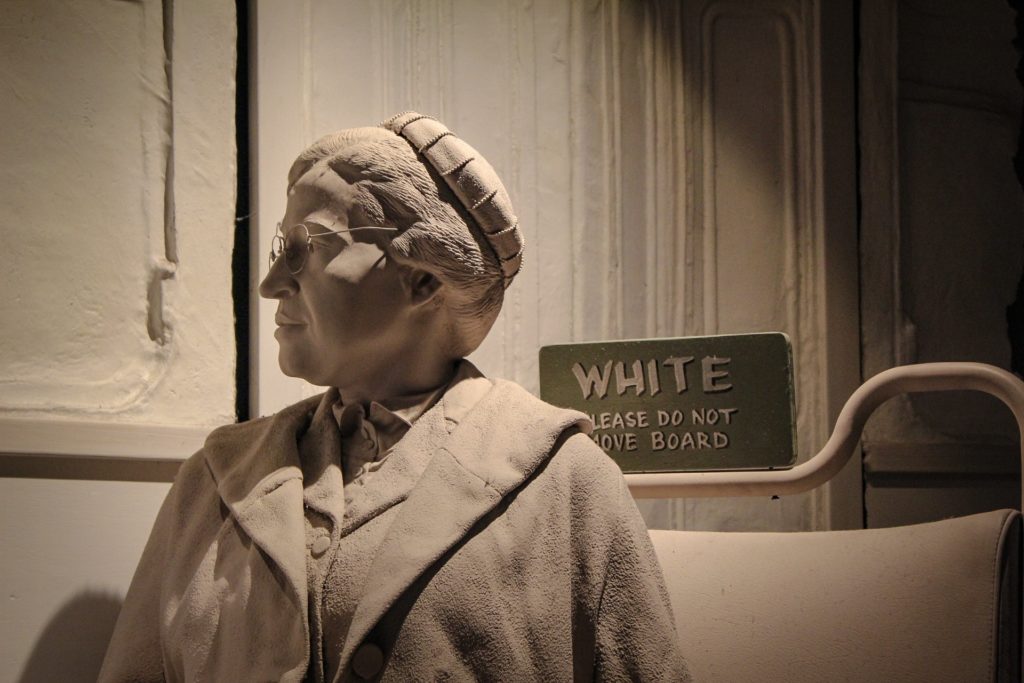
So Much Hate
One of the things that hit me the most at the National Memorial was that there were 592 documented lynchings in Georgia. In our very own state — the only state I know my way around, the only state I’ve grown up in — there was so much hate. I can’t imagine the fear a black person had to live with: the fear of being hanged from a tree, possibly left there as a threat to others, for something as simple as smiling at a white person. That 592 is only the documented lynchings; think about the undocumented lynchings. It hurts me to think about. In 2019, we don’t have any lynchings, but I never want America to forget what they did. It is a part of our history. We can’t make change until we acknowledge our problem.
I will never forget the moment at the Equal Justice Initiative when we met a man who had been sentenced to die in prison. I saw him working in the museum, and it didn’t even cross my mind that someone who I was in the room with could possibly have been in prison. It struck me that you truly don’t know everyone’s story, and everyone has a different one. If you walk down the street, people aren’t wearing signs that say, “I was a prisoner,” “I am an alcoholic,” or “I lost a parent when I was younger.” When he told his story, I immediately felt sorrow that he had to waste valuable years in prison and anger that it was our country’s fault.
One of the men on the visitation simulator at The Legacy Museum said, “It doesn’t matter how long, how dark that tunnel is. There is always light at the end of the tunnel.” To get out of prison and still have a mindset like this is just amazing. I can’t imagine being locked up in a 5-by-7 cell and still telling myself that better is yet to come. Hearing and seeing someone in prison like that was one of the best things in that museum. It was interesting to hear someone’s story. To look them in the eyes and see their history was sad, but at the same time I got to share a moment with them.
–Arden Lunsford
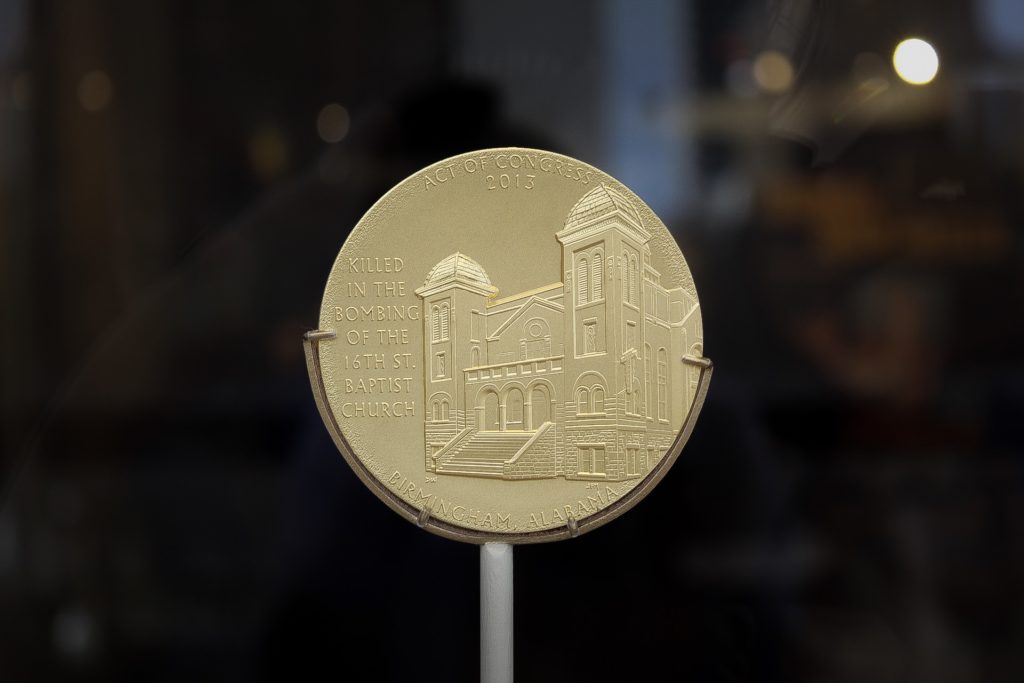
Please Don’t Throw Me Away
I was constantly thinking about the names, stories, and legacies that were forgotten. The National Memorial for Peace and Justice in Montgomery, Alabama was where it was laid out for me to process. There were so many African-American people whose lives were taken away — by lynchings, slavery, and mass incarceration — with no good explanation. There is no way to bring back the silenced or right our wrongs. The worst thing we could do is make the unknown the forgotten, because that leads to repetition of history.
“Please don’t let them throw me away for being a stupid, young, black, kid,” wrote L.T., a teenage boy, from prison to the Equal Justice Initiative. This letter, now displayed in the Legacy Museum, really struck me. We will never have a free country until every baby is born free of the assumptions against them.
If we send children of color into this world thinking they are as free as white children, are we helping them or not? It’s sad how young L.T. must realize that why he is in prison is not all his fault, but because of his race. Not that people can get arrested just for being a certain race, but it’s easier for police to blame them and get away with it. It’s also upsetting that he sees how easily he can fade into the shadows if not given another chance.
Through every exhibit we saw, there was one common thread: hope and faith, mostly in God. That was especially true in the Legacy Museum, where the slaves were behind bars which looked so real because it was a hologram. Imagine everyone you loved being ripped away from you and you are working yourself to the grave, being beaten to death. I can only think it would be easy to give up on God and tell yourself that He does not have a plan for you and will not save you. Throughout everything, though, people sang and prayed for God to get them out of troubled times. How are we supposed to ever get through our struggles living in a racially diverse country that claims to be free without faith today? Maybe not faith in God but faith in each other.
—Lily Grill
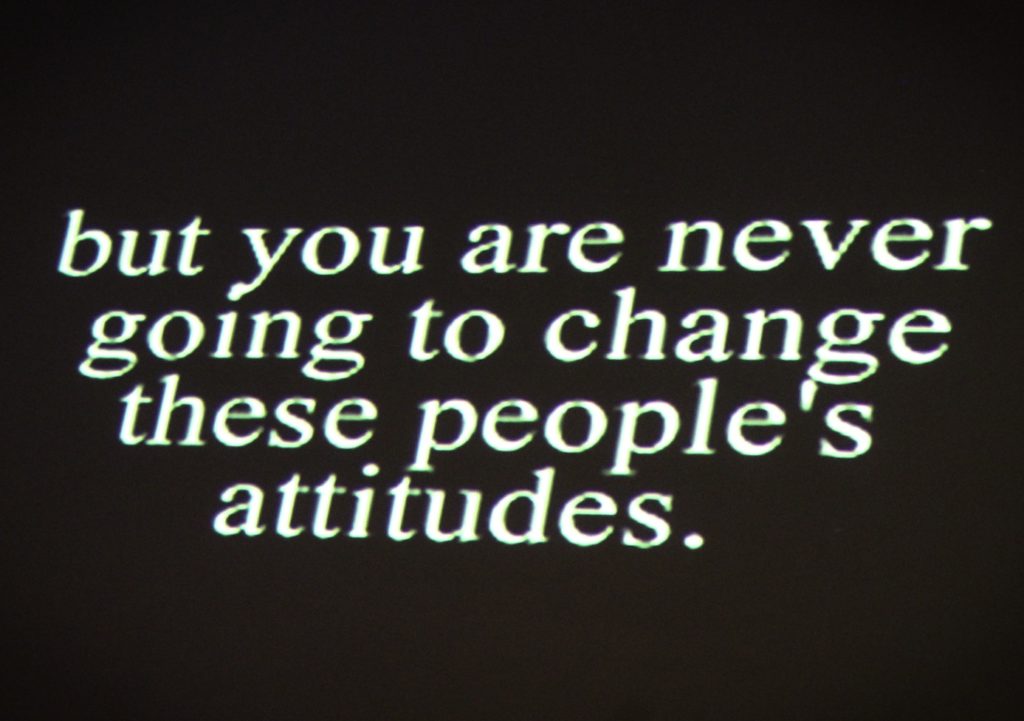
Love Your Neck
During our trip to Alabama, I visually experienced the oppression and racist terrorism that has happened in our country more deeply than I had before. I had learned about slavery and segregation in previous years, but the museums and memorial gave me a new understanding of awful it was and how unfair our criminal justice system still is.
The National Memorial was heartbreaking. Even knowing the number of documented lynchings in America before visiting the memorial, seeing the hanging blocks with the names and dates made a much stronger impact.
As we came out of the memorial, these words by author Toni Morrison were inscribed on the wall: “And O my people, out yonder, hear me, they do not love your neck un-noosed and straight. So love your neck; put a hand on it, grace it, stroke it and hold it up. And all your inside parts that they’d just as soon slop for hogs, you got to love them. The dark, dark liver — love it, love it and the beat and beating heart, love that too.”
I sat on the bench and reread this quote three times because it shows how black people were not being treated like human beings by white people, and so black people have to love themselves because they do not. Morrison is talking about all of the lynchings, which we had just learned about before in the museum and was shown in the memorial before, and tries to show that black people are beautiful and white people don’t define them.
When we were leaving the Legacy Museum, I was standing next to two black women reading about how the “father of modern gynecology” did inhumane experiments on black women because he believed black people did not feel pain. One of the women said, “So I’m not supposed to feel pain?” This stuck with me throughout the trip because it shows how horribly black people were treated and how racism is still affecting people today. Going to these museums as a white person was very different than if I were black, but seeing the raw reaction of a black woman reading a devastating fact showed me just how much black people have had to go through.
I learned so many important things about the Civil Rights Movement and the history of racism in our country during this trip. These will stick with me for the rest of my life and have changed the way I look at our society today.
—Phoebe Schwartz
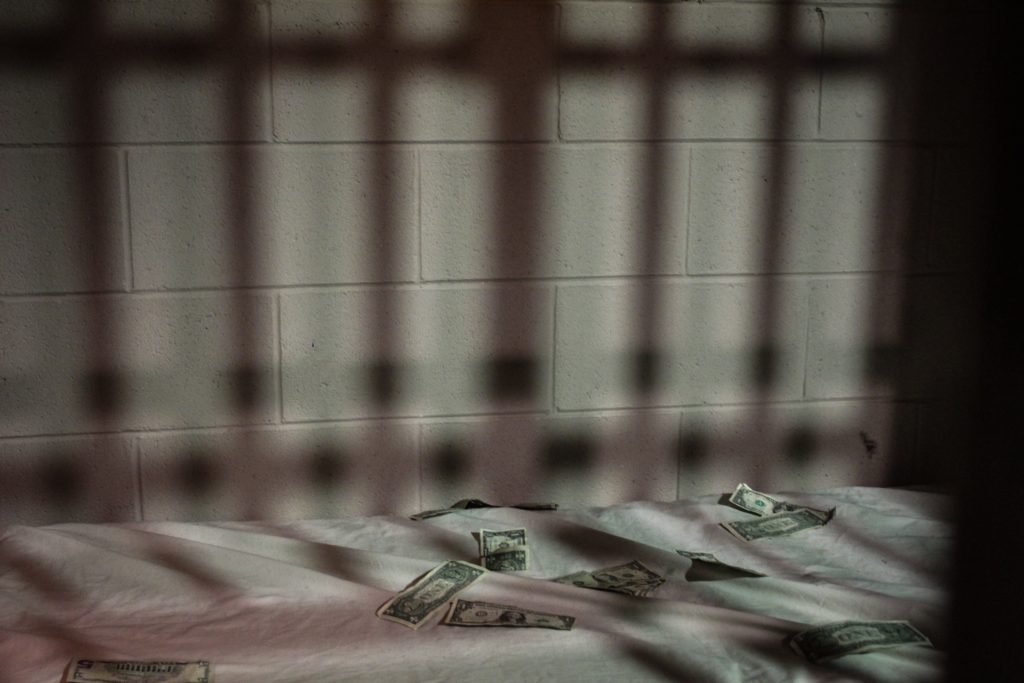
Slavery-to-Prison Timeline
I was astonished on how uninformed I was about lynchings, slavery-to-prison, and the Civil Rights Movement. I was wondering why I know all about the Roman Empire and the Revolutionary War, but little to nothing about the topics listed above. One fact that stood out to me at the Legacy Museum was that in Norway only 20 percent of people who were incarcerated return to prison, while in the U.S. 70 percent return to prison. I learned that prisons start off with the same goal, but Norway and the U.S.’s prisons goals and messages are different. This statistic made me want to dig deeper on why the U.S. took this path. I have always thought of prisons as place where high-end criminals go until I was saddened to learn how much prisons wanted to imprison people. The Legacy Museum did a great job of showing the development of U.S. prisons.
Another thing that also stood out to me was the timeline of slavery to prison. It felt like I was living on another planet. The visual timeline connected the idea in a way a teen like me could understand. It has helped connect the puzzle of history to present day, which I feel schools need to do a better job with. This all seemed like history; I never knew that this discrimination is going on today.
The National Memorial for Peace & Justice was also really meaningful. Words cannot describe the pain I felt when I imagined those innocent victims and what their families went through. The trip made me become aware of a lot of present and past issues that are very unknown. It makes me feel upset that I am an American.
—Jared Hammerstrom

